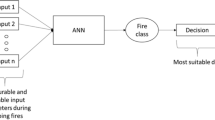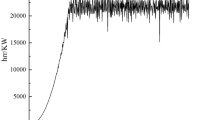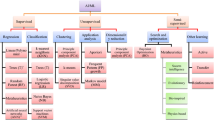Abstract
The prediction of the coal mine fire response time, defined as the remaining time before conditions at attack positions grow untenable for firefighters, plays a vital role in the decision-making process during a mine fire scenario. The knowledge of the response time along with the fire size, fire location, and arrival time could allow for the most suitable decision regarding direct or remote approach to the fire in the mine, mine evacuation planning, and remote attack from the surface. For this reason, this paper presents a data-driven approach to predict the response time and fire size based on available and measurable parameters during underground coal mine fires using two interconnected artificial neural networks (ANNs). A total of 300 fire dynamic simulator (FDS) and fire and smoke simulator (FSSIM) simulations of a straight and flat mine entry (replicating a belt entry) with different fire sizes, air velocities, and dimensions were used in training and testing the ANNs. The results showed that 95% of fire size and response time predictions should be within ± 29 kW and ± 4 s of true values obtained in the fire models, respectively. The approach presented in this work can provide instantaneous predictions of response time and fire size during ongoing mine fires. Additionally, this approach can be utilized in other mine fire locations as well as in different types of tunnels.










Similar content being viewed by others
Data Availability
All datasets and codes used for supporting the conclusions of this article are available upon request at the following website:
https://drive.google.com/drive/folders/1KEGBPD46T2B8PGabhVTkqL9CrAxHw1nR?usp=sharing
References
Conti RS, Chasko LL, Wiehagen WJ, and Lazzara CP (2000) “An underground coal mine fire preparedness and response checklist: the instrument,” Pittsburgh, PA
Conti RS, Chasko LL, Wiehagen WJ, and Lazzara CP (2005) “Fire response preparedness for underground mines,” Pittsburgh, PA
Trevits MA, Yuan L, Teacoach K, Valoski MP, Urosek JE (2009) “Understanding mine fires by determining the characteristics of deep-seated fires,” in SME Annual Conference
Brake DJ (2013) “Fire modelling in underground mines using Ventsim visual VentFIRE software,”. The Australian mine ventilation conference
Yu LX, Beji T, Maragkos G, Liu F, Weng MC, Merci B (2018) Assessment of numerical simulation capabilities of the fire dynamics simulator (FDS 6) for planar air curtain flows. Fire Technol 54(3):583–612. https://doi.org/10.1007/s10694-018-0701-7
Kerber S, Milke JA (2007) Using FDS to simulate smoke layer interface height in a simple atrium. Fire Technol 43(1):45–75. https://doi.org/10.1007/s10694-007-0007-7
Hadjisophocleous G, Jia Q (2009) Comparison of FDS prediction of smoke movement in a 10-storey building with experimental data. Fire Technol 45(2):163–177. https://doi.org/10.1007/s10694-008-0075-3
Shen TS, Huang YH, Chien SW (2008) Using fire dynamic simulation (FDS) to reconstruct an arson fire scene. Build Environ 43(6):1036–1045. https://doi.org/10.1016/j.buildenv.2006.11.001
Salem AM (2013) Parametric analysis of a cabin fire using a zone fire model. Alexandria Eng J 52(4):627–636. https://doi.org/10.1016/j.aej.2013.10.001
Peacock RD, Forney GP, and Reneke PA (2015) “NIST technical note 1889v3 CFAST – consolidated fire and smoke transport (version 7) volume 3 : verification and validation guide,” 3 7 https://doi.org/10.6028/NIST.TN.1889v2
Buffington T, Cabrera JM, Kurzawski A, Ezekoye OA (2020) Deep-learning emulators of transient compartment fire simulations for inverse problems and room-scale calorimetry. Fire Technol. https://doi.org/10.1007/s10694-020-01037-2
Lee J, Lee S, and You D (2018) “Deep learning approach in multi-scale prediction of turbulent mixing-layer,” 1–21. https://doi.org/10.48550/arXiv.1809.07021
Lee S, and You D (2017) “Prediction of laminar vortex shedding over a cylinder using deep learning,” no. Wu 2011. https://doi.org/10.48550/arXiv.1712.07854
Miyanawala TP, and Jaiman RK (2017) “An efficient deep learning technique for the Navier-Stokes equations: application to unsteady wake flow dynamics,”. https://doi.org/10.48550/arXiv.1710.09099
Raissi M, Yazdani A, and Karniadakis GE (2018) “Hidden fluid mechanics: a Navier-Stokes informed deep learning framework for assimilating flow visualization data,”. https://doi.org/10.48550/arXiv.1808.04327
Maulik R, San O (2017) A neural network approach for the blind deconvolution of turbulent flows. J Fluid Mech 831:151–181. https://doi.org/10.1017/jfm.2017.637
Hodges JL, Lattimer BY, Luxbacher KD (2019) Compartment fire predictions using transpose convolutional neural networks. Fire Saf J 108(November 2018):102854 2019. https://doi.org/10.1016/j.firesaf.2019.102854
US Code of Federal Regulations (2016) CFR, title 30 (mineral resources) part 75. Mandatory safety standards—underground coal mines. United States. https://www.ecfr.gov/current/title-30/chapter-I/subchapter-O/part-75?toc=1
M. Abadi et al. (2016) “TensorFlow: large-scale machine learning on heterogeneous distributed systems,”
F. Chollet, “Keras,” GitHub repository, 2015. [Online]. Available: https://www.github.com/fchollet/keras
NFPA (2020) NFPA 502:standard for road tunnels, bridges, and other limited access highways
Gehandler J, Ingason H, Lönnermark A, Frantzich H, and Strömgren M (2013) Performance-based requirements and recommendations for fire safety in road tunnels (FKR-BV12)
Ingason H, Li YZ, and Lönnermark A (2015) “Tunnel fire ventilation,” in Tunnel fire dynamics, 53, 9, New York, NY: Springer New York, 333–360.
Haghighat A, Luxbacher K (2018) Tenability analysis for improvement of firefighters’ performance in a methane fire event at a coal mine working face. J Fire Sci 36(3):256–274. https://doi.org/10.1177/0734904118767066
Fridolf K, Andrée K, Nilsson D, Frantzich H (2014) The impact of smoke on walking speed. Fire Mater 38(7):744–759. https://doi.org/10.1002/fam.2217
McGrattan K, Hostikka S, Floyd J, Mcdermott R, Weinschenk C, and Overholt K (2016) Sixth edition fire dynamics simulator user’s guide, 1019
McGrattan KB, Mcdermott R, Hostikka S, Floyd J, Weinschenk C, Overholt K (2016) Fire dynamics simulator user’s guide. Gaithersburg, MD
McGrattan K, Hostikka S, McDermott R, Floyd J, Weinschenk C, and Overholt K (2015) “Fire dynamics simulator technical reference guide volume 1: mathematical model (sixth edition). NIST Spec Publ 1018 1
Li YZ, Ingason H (2017) Effect of cross section on critical velocity in longitudinally ventilated tunnel fires. Fire Saf J 91(May):303–311. https://doi.org/10.1016/j.firesaf.2017.03.069
Li YZ, Lei B, Ingason H (2010) Study of critical velocity and backlayering length in longitudinally ventilated tunnel fires. Fire Saf J 45(6–8):361–370. https://doi.org/10.1016/j.firesaf.2010.07.003
Oka Y, Atkinson GT (1995) Control of smoke flow in tunnel fires. Fire Saf J 25(4):305–322. https://doi.org/10.1016/0379-7112(96)00007-0
Thomas PH (1958) “The movement of buoyant fluid against a stream and the venting of underground fires” Fire Res Stn351
Thomas PH (1968) “The movement of smoke in horizontal passages against an air flow.,” Fire Res Stn 723
Vauquelin O (2005) Parametrical study of the back flow occurrence in case of a buoyant release into a rectangular channel. Exp Therm Fluid Sci 29(6):725–731. https://doi.org/10.1016/j.expthermflusci.2005.01.002
Wu Y, Bakar MZA (2000) Control of smoke flow in tunnel fires using longitudinal ventilation systems - a study of the critical velocity. Fire Saf J 35(4):363–390. https://doi.org/10.1016/S0379-7112(00)00031-X
McGrattan K, Baum H, Rehm R (1999) Large eddy simulations of smoke movement. ASHRAE Trans 105:426
Floyd JE, Hunt SP, Williams FW, and Tatem PA (2005) A network fire model for the simulation of fire growth and smoke spread in multiple compartments witcomplex ventilation 15. https://doi.org/10.1177/1042391505051358
Haghighat A, Luxbacher K, Lattimer BY (2018) Development of a methodology for interface boundary selection in the multiscale road tunnel fire simulations. Fire Technol 54(4):1029–1066. https://doi.org/10.1007/s10694-018-0724-0
Acknowledgements
The findings and conclusions in this report are those of the authors and do not reflect the official policies of the Department of Health and Human Services; nor does mention of trade names, commercial practices, or organizations imply endorsement by the US Government.
Funding
This research was funded by the National Institute Safety and Health (NIOSH) under Contract No. 200–2014-59669.
Author information
Authors and Affiliations
Corresponding author
Ethics declarations
Conflict of Interest
The authors declare no competing interests.
Additional information
Publisher's Note
Springer Nature remains neutral with regard to jurisdictional claims in published maps and institutional affiliations.
Rights and permissions
About this article
Cite this article
Barros-Daza, M.J., Luxbacher, K.D., Lattimer, B.Y. et al. Fire Size and Response Time Predictions in Underground Coal Mines Using Neural Networks. Mining, Metallurgy & Exploration 39, 1087–1098 (2022). https://doi.org/10.1007/s42461-022-00580-6
Received:
Accepted:
Published:
Issue Date:
DOI: https://doi.org/10.1007/s42461-022-00580-6




